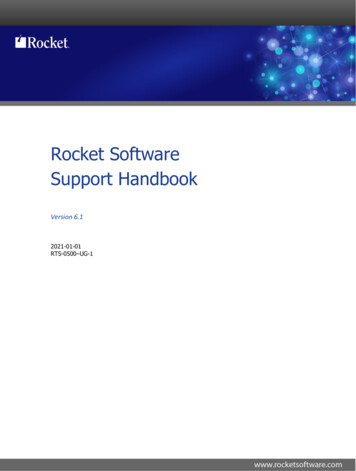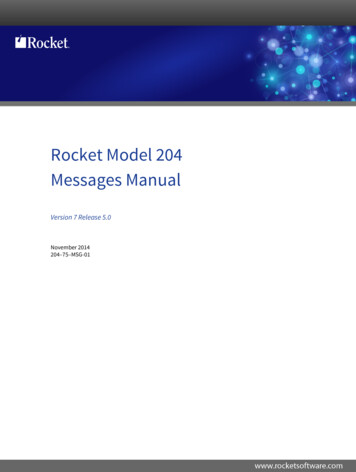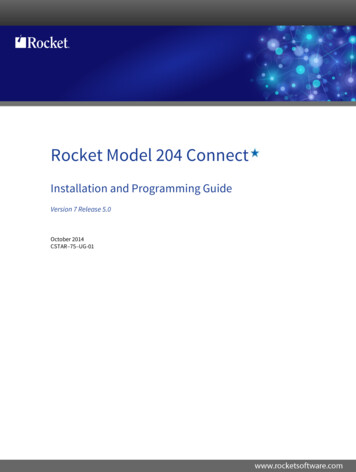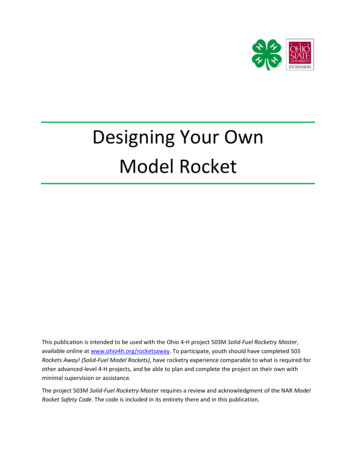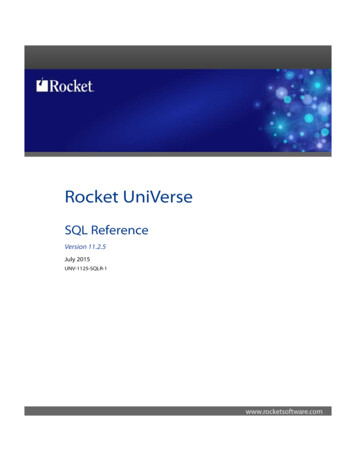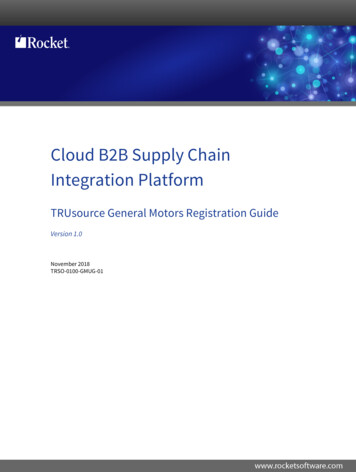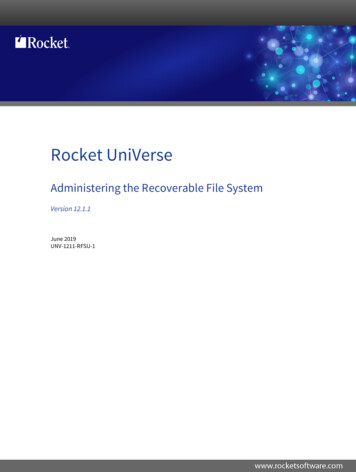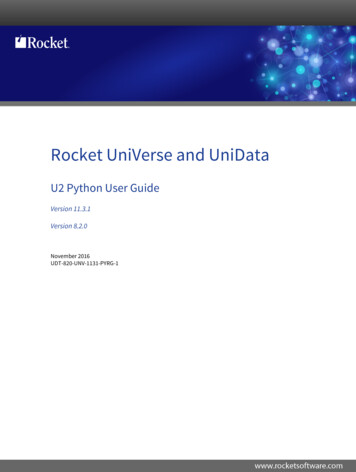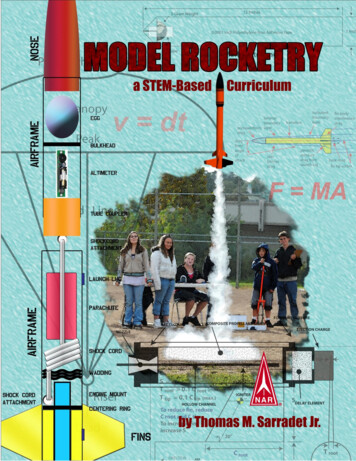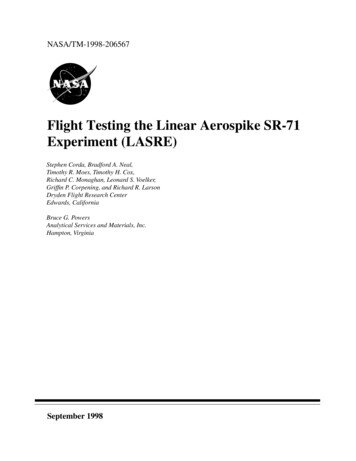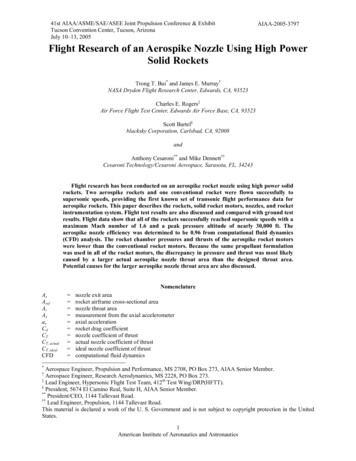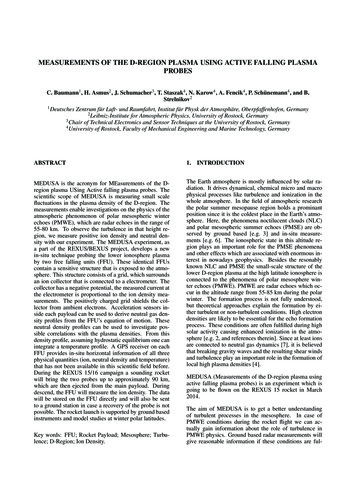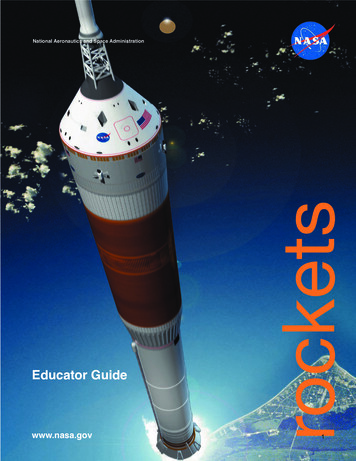
Transcription
Educator Guidewww.nasa.govrocketsNational Aeronautics and Space Administration1
rocketPronunciation: \rä-kət\ noun (It rocchetta)USAA vehicle, typically cylindrical, containing liquid or solidpropellants which produce hot gases or ions that are ejectedrearward through a nozzle and, in doing so,U creates anNaction force accompanied by an opposite andequal reactionITE rockets are selfforce driving the vehicle forward. BecauseDcontained, they are able to operate in outer space.STATESDISCOVERY2
National Aeronautics and Space AdministrationROCKETSEducator’s Guide with Activities inScience, Technology, Engineering and MathematicsThis publication is in the Public Domain and is not protected by copyright.Permission is not required for duplication.EG-2008-05-060-KSC3
AcknowledgementsThe original Rockets Teacher Guide waspublished by NASA’s Education Division in themid-1990s. It has found widespread use inboth formal and informal educational settingsbecause of the exciting nature of the topic andbecause of its dynamic classroom activitiesthat match and support both national and stateeducation standards for science, mathematics,and technology.This revision of the guide, by the originalauthors, updates educators on NASA’s 21stCentury Space Exploration Policy and thevehicles that will make this vision possible.It builds on classroom experience with theoriginal guide and presents a suite of improvedand new activities that prepare students for thefuture of space exploration.Many educators and scientists havecontributed ideas and content directly andindirectly to this revision. Their assistance isgratefully appreciated.Authors:Deborah A. ShearerPrincipal, College Park ElementaryLaPorte, TexasGregory L. Vogt, Ed.D.Educational consultantSpecial Thanks To:NASA HeadquartersJerry G. HartmanMerrill King, Ph.D.Allota TaylorCarla RosenbergSpecial appreciation is extendedto NASA's Exploration SystemsMission Direcorate and SpaceOperations Mission Directoratefor their generosity andcommitment to the continuationof this educational project.NASA Kennedy Space CenterGregg Buckingham, Ed.D.Lesley Garner, Ph.D.Sharon FeganJames SudermanMarshall Space Flight CenterRobert ArmstrongTwila SchneiderPennsylvania State UniversityJames GerardLes GoldDynamac CorporationMichael MartinValerie JonesEditor:Maury Solomoni
Dear Educators:NASA has embarked on a 21st Century Space Exploration Policy that will establish a permanenthuman presence on the Moon and carry astronauts to Mars and beyond. The best ideas of ourspace exploring past are being merged with dreams for the future. It is a wonderful time for youand your students to learn about science, technology, engineering, and mathematics. Rocketswill be your vehicle for learning.The Rockets Educator Guide provides you and your students many opportunities. Together, youwill examine early rockets and meet thinkers and dreamers. You will learn about rocket scienceand mathematics and what rocket scientists do. You will see pictures of events and technologiesthat many of us grew up with - Sputnik, Apollo and the Moon, and the space shuttle to name afew. You will see what the future of space transportation will look like. You will learn why rocketsare the only vehicles we can use to “go where no one has gone before.”Will your students be a part of this future in space? Will they be the scientists, technicians,engineers, and mathematicians that make dreams of exploring space possible? Yes! This guidewill help you prepare them for the wonders that are coming.Chapters within the guide present the history of rocketry, NASA’s 21st Century Space ExplorationPolicy, rocketry principles, and practical rocketry. These topics lay the foundation for whatfollows - a wealth of dynamic rocket science classroom activities that work. The activitiesfocus on Sir Isaac Newton’s laws of motion and how they apply to rockets. They incorporatecooperative learning, problem solving, critical thinking, and hands-on involvement. They supportnational and state standards for science, mathematics, and technology across many gradelevels.All of the activities are designed with the classroom in mind. They include clear descriptions,background information for the teacher and student, detailed procedures and tips, lists of readilyavailable materials, assessments, questions for discussion, and extensions. The activities aredesigned to foster excitement and a passion for learning.The guide is versatile. It has been created as a two to six week classroom unit depending uponthe grade level of the students but individual activities can be extracted and used as stand-aloneclassroom experiences. You will find activity objectives and principles clearly stated along withthe vocabulary terms necessary for understanding the principles involved.The goal of the Rockets Educator Guide is to excite young minds. Among your students arefuture leaders, planners, builders, explorers, settlers, and interplanetary pilots! This guide willhelp you lay the groundwork for their future in space.ii
Table of ContentsLetter to Educators . . . . . . . . . . . . . . . . . . . . . . . . . . iiA Pictorial History of Rockets . . . . . . . . . . . . . . . . . . 1What Comes Next . . . . . . . . . . . . . . . . . . . . . . . . . . . 13How Rockets Work . . . . . . . . . . . . . . . . . . . . . . . . . . 19Applying Newton’s Laws . . . . . . . . . . . . . . . . . . . . . . 24Activities . . . . . . . . . . . . . . . . . . . . . . . . . . . . . . . . . . 30National Standards Matrix . . . . . . . . . . . . . . . . . . 31Suggested Grade Levels . . . . . . . . . . . . . . . . . . . 33Pop Can “Hero Engine” . . . . . . . . . . . . . . . . . . . . 343.2.1.PUFF!. . . . . . . . . . . . . . . . . . . . . . . . . . . 40Heavy Lifting. . . . . . . . . . . . . . . . . . . . . . . . . . . . . 46Newton Car . . . . . . . . . . . . . . . . . . . . . . . . . . . . . 51Rocket Races . . . . . . . . . . . . . . . . . . . . . . . . . . . . 56Pop! Rocket Launcher . . . . . . . . . . . . . . . . . . . . . 63Pop! Rockets . . . . . . . . . . . . . . . . . . . . . . . . . . . . 66Foam Rocket . . . . . . . . . . . . . . . . . . . . . . . . . . . . 72Launch Altitude Tracker . . . . . . . . . . . . . . . . . . . . 80High-Power Paper Rocket Launcher . . . . . . . . . . 86High-Power Paper Rockets . . . . . . . . . . . . . . . . . 91Rocket Wind Tunnel . . . . . . . . . . . . . . . . . . . . . . . 97Advanced High-Power Paper Rockets . . . . . . . 103Water Rocket Launcher . . . . . . . . . . . . . . . . . . 109Water Rocket Construction . . . . . . . . . . . . . . . 114Project X-51 . . . . . . . . . . . . . . . . . . . . . . . . . . . 118Rocket Scientist Certificate . . . . . . . . . . . . . . . 138Careers . . . . . . . . . . . . . . . . . . . . . . . . . . . . . . . 139Above and Beyond-Additional Explorations . . . 140How High? . . . . . . . . . . . . . . . . . . . . . . . . . . 141Science Fiction . . . . . . . . . . . . . . . . . . . . . . 144Space Art . . . . . . . . . . . . . . . . . . . . . . . . . . . 146Glossary . . . . . . . . . . . . . . . . . . . . . . . . . . . . . . . . . 148NASA Educational Resources . . . . . . . . . . . . . . . . . 149Evaluation . . . . . . . . . . . . . . . . . . . . . . . . . . . . . . . 151iii
A PictorialHistory ofRocketsThe mighty space rockets of today are theresult of more than 2,000 years of invention,experimentation, and discovery. First byobservation and inspiration and then bymethodical research, the foundations formodern rocketry were laid. Humans havetraveled into space and walked on the Moon.Soon, we will travel to the Moon to establish apermanent base and later expand the humanpresence to Mars and beyond. Already, travelto the stars is possible. Robot spacecraft areon their way into interstellar space as you readthis. Someday, they will be followed by humanexplorers.Often lost in the shadows of time, earlyrocket pioneers “pushed the envelope” bycreating rocket-propelled devices for land,sea, air, and space. When the scientificprinciples governing motion were discovered,rockets graduated from toys and novelties toserious devices for commerce, war, travel, andresearch. This work led to many of the mostamazing discoveries of our time.The vignettes that follow provide a smallsampling of stories from the history of rockets.They form a rocket time line that includescritical developments and interesting sidelines.In some cases, one story leads to another, andin others, the stories are interesting diversionsfrom the path. They portray the inspirationsthat ultimately led to us taking our first stepsinto outer space. The new Ares rockets and therockets that follow owe much of their successto the accomplishments presented here.1
Steam, Sparks, Explosions, and FlightArchytas, 428 to 347 B.C.Archytas, a Greek philosopher, mathematician, and astronomer wassaid to have constructed and flown a small bird-shaped device thatwas propelled by a jet of steam or compressed air. The ‘bird’ mayhave been suspended by a wire or mounted at the end of a bar thatrevolved around some sort of pivot. This was the first reported deviceto use rocket propulsion.Hero Engine, c. A.D. 10 to 70Though not a rocket, the main principle behind rocket (and jet)propulsion was employed in a steam engine invented by Hero ofAlexandria. The exact appearance of Hero’s engine is not known, butit consisted of some sort of copper vessel heated by a fire beneath.Water in the vessel turned into steam and traveled up two tubes toa hollow sphere that was free to rotate. Two L-shaped tubes fromthe sphere allowed the steam to escape in jets of gas. The sphererotated rapidly in the opposite direction of the jets. The Hero enginewas seen as an amusing toy, and its potential was not realized for athousand years.Chinese Fire Arrows, A.D. 1232The origins of gunpower are not clear, but the Chinese reportedlyhad a rudimentary form of it in the first century, A.D. A mixture ofsaltpeter, sulfur, and charcoal dust produced colorful sparks andsmoke when ignited. The powder was used to make fireworks.Tubes of bamboo and leather, closed off at one end, were packedwith gunpowder. Depending upon how the powder was packedand the size of the opening, a fountain of sparks or a bang wouldresult when the powder was ignited. It is likely that some fireworksskittered about because of the thrust produced from the gasesescaping the open end. Thus the rocket was born. By 1232, theseprimitive rockets were attached to arrows and used to repel Mongolinvaders in the battle of Kai-keng.Roger Bacon, c. 1214 to c. 1292A monk, Bacon wrote about gunpowder in his The Epistola Fratris R.Baconis, de secretis operibus artis et naturase et nullitate magiae:“We can, with saltpeter and other substances, compose artificially a firethat can be launched over long distances.By only using a very smallquantity of this material much light can be created accompanied by ahorrible fracas. It is possible with it to destroy a town or an army.”Bacon is thought to have developed improved gunpowderformulas that greatly increased the mixture’s power.2
Wan Hu, Sixteenth CenturyAccording to legend Wan Hu, a Chinese stargazer and local officialliving sometime around the middle of the Ming dynasty, dreamedof spaceflight. He constructed a chair and attached 47 gunpowderrockets to its base. In some versions of the story, his chair alsohad kite wings. On launch day, 47 assistants rushed up andsimultaneously lit the fuses of all the rockets. A huge explosionfollowed. When the smoke cleared, Wan Hu was gone. Somehave suggested Wan Hu actually made it into space, and you cansee him as the “Man in the Moon.” Regardless of the actual end,Wan Hu had the right idea—use rockets to travel into space.Rockets Go to WarFor centuries to come, rockets competed with cannons as theweapon of choice for war. Each technological developmentmoved one or the other system into or out of favor. Cannons weremore accurate. Rockets could be fired more quickly. Breechloading cannons speeded up the firing. Rocket fins increasedaccuracy. Cannons had greater range. Rockets had greaterrange. And so on. Invention abounded. Invented by Joanes deFontana of Italy (1420), a surface-running rocket torpedo wassupposed to set enemy ships on fire.Kazimierz Siemienowicz, c. 1600 to c. 1651Kazimierz Siemienowicz, a Polish-Lithuanian commander in thePolish Royal Artillery, was an expert in the fields of artillery androcketry. He wrote a manuscript on rocketry that was partiallypublished before his death. In Artis Magnae Artilleriae pars prima,he published a design for multistage rockets that was to becomefundamental rocket technology for rockets heading for outer spaceSiemienowicz also proposed batteries for military rocket launchingand delta-wing stabilizers to replace the guiding rods currently inuse with military rockets. It was rumored that Siemienowicz waskilled by members of guilds that were opposed to him publishingtheir secrets, and they hid or destroyed the remaining parts of hismanuscript.The Birth of Rocket ScienceGalileo Galilei, 1564 to 1642In addition to his many other accomplishments, this Italianastronomer and mathematician rekindled the spirit of scientificexperimentation and challenged old beliefs relating to mass andgravity. He proved that an object in motion does not need thecontinuous application of force to keep moving. He called thisproperty of matter, which causes it to resist changes in velocity,“inertia.” Inertia is one of the fundamental properties that IsaacNewton would later incorporate into his laws of motion.3
Newton’s Laws of Motion, 1642 to 1727English scientist Sir Isaac Newton condensed all rocket science intothree elegant scientific laws. Published in Philosophiae NaturalisPrincipia Mathematica his laws, previously understood intuitivelyby early rocketeers, provided the foundation for all modern rocketscience. (The “Rocket Principles” chapter focuses on these lawsand the “Practical Rocketry” chapter demonstrates the applicationsof these laws.)Colonel William Congreve, 1772 to 1828Following stunning rocket barrages against the British by theforces of Tippoo Sultaun of India, William Congreve took chargeof British military rocket companies. Some of his designs hadoperational ranges of 6,000 yards. He created both case-shotrockets that sprayed the enemy with carbine balls and incendiaryrockets for burning ships and buildings. He invented launchingrockets from ships. The phrase “by the rocket’s red glare,” coinedby Francis Scott Key during the War of 1812, referred to Britishlaunched Congreve rockets.Jules Verne, 1828 to 1905The dream of traveling through space was brought to life by Frenchscience fiction writer Jules Verne. In his De la Terre á la Lune, Verneused a giant cannon to fire a manned projectile at the Moon. Althoughnot a rocket, the projectile had some interesting parallels with thefuture Apollo Moon program. It was called the Columbiad andcontained a crew of three. It was fired at the Moon from Florida. TheApollo 11 capsule was named Columbia, contained a crew of three,and was launched from Florida. Verne correctly described how thecrew would feel “weightless” on their voyage. Of course, the crewwould not have survived the initial acceleration of the cannon firing.Nevertheless, Verne, an early space exploration visionary, fired theimaginations of many would-be rocketeers and future astronauts.Modern Rocket PioneersKonstantin E. Tsiolkovski, 1857 to 1935Konstantin Tsiolkovski was a teacher, theorist, and astronauticspioneer. Son of a Polish forester who emigrated to Russia, he wroteand taught extensively about human space travel and is consideredthe father of cosmonautics and human spaceflight. Tsiolkovskiadvocated liquid propellant rocket engines, orbital space stations,solar energy, and colonization of the Solar System. His most famouswork, “Research into Interplanetary Space by Means of RocketPower,” was published in 1903, the same year the Wright brothersachieved powered and controlled airplane flight. His rocket equation,based on Newton’s second law of motion, relates rocket engineexhaust velocity to the change in velocity of the vehicle itself.4
Robert H. Goddard, 1882 to 1945American college professor and scientist Robert Goddard builtand flew the world’s first liquid propellant rocket on March 16,1926. Its flight, though unimpressive (it climbed only 12.5 meters),was the forerunner of the Saturn V Moon rocket 43 years later. Atthe request of local townsfolk, Goddard moved his experimentsfrom Auburn, Massachusetts, to the deserts around Roswell, NewMexico. There he continued his experiments and developed agyroscope system to control his rockets in flight, instrumentationpayload compartments, and parachute recovery systems. He isoften referred to as the “father of modern rocketry.”Hermann Oberth, 1894 to 1989Hermann Oberth, a Romanian by birth and a naturalized Germancitizen, became fascinated by the works of Jules Verne anddevoted his life to promoting space travel. His dissertation forthe University of Heidelberg, rejected for being too speculative,became the basis for his book Die Rakete zu den Planetanraumen(By Rocket to Space). The book explained the mathematicsof spaceflight and proposed practical rocket designs andspace stations. This and other books inspired a generationof rocketeers. Rocket societies sprang up around the world,including the German Verein fur Raumschiffart (Society for SpaceTravel) that led to the development of the V2 rocket.Rocket Experimenters, Early Twentieth CenturyIn the 1920s and 1930s, leading up to World War II, amateurrocketeers and scientists worldwide attempted to use rocketson airplanes, racing cars, boats, bicycles with wings, throw linesfor rescuing sailors from sinking ships, mail delivery vehicles foroff-shore islands, and anything else they could dream up. Thoughthere were many failures, experience taught the experimentershow to make their rockets more powerful and more reliable.World War IIFlying BombsThe necessities of war led to massive technological improvementsin aeronautics and rocketry. Almost overnight, rockets graduatedfrom novelties and dream flying machines to sophisticatedweapons of destruction. Rockets propelled nearly unstoppableGerman fighter planes and Japanese Kamikaze pilots with bombsinto ships. War would never be the same again.5
Vergeltungswaffe 2 - V2In the late 1930s, the German Verein fur Raumschiffart Society forSpace Travel evolved into the team that built and flew the mostadvanced rocket for the time, the V2. On the shores of the BalticSea, the team, under the directorship of Wernher von Braun, createda rocket powered by alcohol and liquid oxygen. With a range of320 kilometers (200 miles) and a maximum altitude of 88 kilometers(55 miles), the V2 could deliver a 1-ton explosive warhead to the heartof London without warning. Thousands of V2s were built, but theyentered the war too late to affect the outcome.The Space Age BeginsBumper ProjectAt the conclusion of the war in Europe, 300 trainloads of V2rockets and parts were captured and shipped to the United Statesalong with the majority of the principal designers, who decidedbeforehand to surrender to American troops. The V2 became thebasis of the intercontinental ballistic missile development programand led directly to the manned space program. Employing one ofthe captured V2 rockets with a WAC Corporal rocket (named forthe Women’s Army Corps) at its top, the initial launch of a “BumperWAC” took place on May 13, 1948. During six flights, the largesttwo-stage rocket launched to date in the United States eventuallyreached an altitude of almost 400 kilometers (250 miles).The World’s First Artificial SatelliteAt the conclusion of World War II, the United States and the SovietUnion engaged in a race for space. The Soviet Union won the firstround by launching its Sputnik I satellite on October 4, 1957. Thesatellite had a spherical design with four antenna. It weighed 83.6kilograms (184.3 pounds). Two months later, the 508.3-kilogram(1,118.26-pound) Sputnik II reached space with a living passenger.Laika, a small dog, orbited Earth for a few hours. Although shedied in space, she led the way for all humans that followed.Explorer 1The United States entered the satellite-launching business onJanuary 31, 1958 with the successful launch of Explorer 1. Thesatellite was launched atop the Juno 1, a modified Jupiter-C booster.Though much smaller than the Sputniks, only 13.93 kilograms (30.66pounds)—Explorer 1’s Geiger counter made the first importantdiscovery about the space environment. Explorer 1 detected aroundEarth what would later be called the Van Allen Radiation Belts.6
X-15Between 1959 and 1968, the X-15 experimental aircraft flew tothe edge of space. In 199 flights, the air-launched rocket planebroke many flight records, including speed (7,274 kph or 4,520mph) and altitude records (108 kilometers or 67 miles). Test flightsestablished important parameters for attitude control in space andreentry angles. Neil Armstrong, the first American to step on theMoon, was one of twelve X-15 pilots.Yuri Gagarin Goes Into OrbitOn April 12, 1961, space became the domain of humans with thelaunch of cosmonaut Yuri Gagarin. His spaceflight lasted 1 hour and48 minutes. During that time, Gagarin orbited Earth one time inside hisVostok 1 space capsule, reaching a maximum altitude of 315 kilometers(196 miles). Upon reentry, Gagarin ejected himself from the capsule atan altitude of 6,100 meters (20,000 feet) and parachuted safely to theground.Freedom 7On May 5, 1961, American astronaut Alan Shepherd, Jr., lifted offfrom Cape Canaveral, Florida, inside his Freedom 7 Mercury spacecapsule, which sat atop a Redstone rocket. The rocket did nothave enough power to send the craft into orbit, and Shepherd madea suborbital flight reaching 187 kilometers (116 miles) before hiscapsule returned to Earth in an ocean splashdown 15 minutes 22seconds later.Moon RocketJust days after Alan Shepard’s flight, President John F. Kennedyaddressed a joint session of Congress and challenged America tosend an American to the Moon and return him safely before the endof the decade. Although it was a shockingly bold announcement,some of the steps to accomplish this mission were already underway.NASA had begun work on components of a rocket capable of a roundtrip lunar flight. By the next year, the rocket was named the Saturn V.It would be 110.6 meters or 363 feet tall, dwarfing all previous rockets.The Saturn V would consist of three stages, a capsule with a smallpropulsion unit for the return trip, and a two-stage lunar lander.7
Glenn Orbits EarthOn February 20, 1962, riding on a more powerful missile, the Atlas,astronaut John H. Glenn, Jr., became the first American to go intoorbit. Glenn’s flight achieved parity with the Soviet program. Glennorbited Earth three times for a total of 4 hours and 55 minutes inspace. A sensor switch led to an early return. The sensor indicatedthat the Mercury capsule heat shield was loose, but the shield waslater determined to be firmly in place during flight. The sensor wasfaulty. The last of the six Mercury flights took place on May 15, 1963,with astronaut Gordon Cooper remaining in space for nearly a dayand a half.Preparing for the MoonProject Gemini followed the Mercury missions. The Gemini spacecapsule, riding on top of a Titan missile, contained two astronauts.During missions lasting up to 14 days, Gemini astronauts pioneeredspacewalking, spacecraft rendezvous, and docking procedures.Important spacecraft systems, needed for the coming Moon flights,were evaluated. Ten Gemini missions were flown during 1965 and1966. The Titan rocket, initially created as an intercontinental ballisticmissile, went on to carry the Viking spacecraft to Mars and theVoyager spacecraft to the outer solar system in the 1970s.Dr. Wernher von BraunOne of the leading figures in the development of pre-war Germany’srocket program and the development of the V2 missile, von Braun(1912-1977) became a leading proponent of America’s space program.He entered the United States after the war and became a naturalizedcitizen. He worked on the development of intercontinental ballisticmissiles and led the development team that launched Explorer 1.Dr. von Braun was the chief architect and engineer of the Saturn VMoon rocket. His popular writings and collaboration with Disney on a“Tomorrowland” TV series did much to inspire the next generation ofrocket scientists and astronauts.Gene RoddenberryGene Roddenberry (1921-1991), a distinguished World War II bomber pilotand commercial pilot, began his writing career penning stories about flying.He began writing for television and developed a concept for a “western”series set among the stars. For three years (1966–1968), the Star Trek seriesexplored a wide range of scientific and social issues as humans traveledacross the galaxy. The series became so popular that the first space shuttleorbiter test vehicle was named Enterprise after the star ship Enterprise. Theoriginal show spawned several companion series and a string of movies.Roddenberry, a visionary, inspired a generation of space travelers.8
“One Small Step.”At 10:56 p.m. EDT, July 20, 1969, American astronaut Neil Armstrongset foot on the Moon. It was the first time in history that humans hadtouched another world. He was followed to the surface by Edwin“Buzz” Aldrin, Jr. A third astronaut, Michael Collins, remained inlunar orbit in the Apollo capsule. The Apollo 11 mission was the firstof six Moon landings extending to the end of 1972. The astronauts’spacecraft, the lunar module, consisted of a descent and an ascentstage. The descent stage had four legs and a powerful rocket engineto slow the craft for landing on the Moon. After surface explorations,the upper part of the lander lifted off, using its own rocket engine,and rendezvoused with the Apollo capsule for the return to Earth.SkylabUsing a modified third stage of the Saturn V rocket, the United Statesfinally launched its first space station, called Skylab, into Earth orbit in1973. Rather than engines and fuel tanks, the interior of the third stagewas fitted with living quarters and laboratories for three astronautson extended stays in space. Solar panels provided electric power.Due to a problem during launch, one of the large panels was lost.Nevertheless, three crews of astronauts called Skylab home until 1974.The last crew remained in space 84 days.Smaller SaturnThe Saturn V rocket was capable of launching 117,900 kilograms(260,000 pounds) into low Earth orbit and 40,800 kilograms (90,000pounds) to the Moon. For some Apollo missions, though, a smallerSaturn was called for. The Saturn IB was 68 meters (224 feet) talland required a scaffold platform nicknamed the “milk stool” to beplaced on the pad designed for Saturn V rockets. This enabled theSaturn IB to match up with swing arms from the launch structure.The Saturn IB carried some of the early Apollo test missions, thethree crews for Skylab, and the American crew for the 1975 historicApollo-Soyuz mission, linking astronauts and cosmonauts in orbit.Orbits and ProbesDeep SpaceThe Titan rockets (1959–2005), used for launching the Geminimissions, found wide use in launching unmanned payloads.Upgraded versions of Titans lofted heavy satellites into Earth orbit andpropelled important spacecraft to other planets. The Viking missionsto Mars and the Voyager missions to the outer planets and interstellarspace are among its credits.9
Sounding RocketsAlthough rockets have generally gotten larger and more powerful,there are many reasons for flying smaller rockets. The Canadian–designed Black Brant sounding rocket has been flying since 1961 andhas successfully completed over 800 flights carrying small payloadssuch as cameras, instruments, and microgravity experiments.The Black Brant’s reliability and low cost has made it a favorite ofresearchers. The biggest multistage Black Brants have payloadcapacities of about 100 kilograms (220 pounds) and can reachaltitudes of up to 900 kilometers (560 miles).ArianeBeginning service in 1979 and continuing today with upgraded versions,the European Space Agency’s Ariane rocket has specialized in launchingcommunications satellites to high geostationary orbits. Ariane islaunched from French Guiana on the eastern coast of South America totake maximum advantage of Earth’s rotational velocity in boosting therocket into orbit.Delta FamilyWith roots going back to the early 1960s, the American Delta rocket isone of the most versatile of the commercial and military payload launchrockets. Delta has many configurations, including multiple stages andheavy-lift strap-on boosters that increase payload capacity to highorbits. The Delta family has logged more than 325 launches, with asuccess rate exceeding 95 percent.AtlasLike the Delta rocket, the Atlas has deep roots. Now in its fifth majorconfiguration, the Atlas was created as a missile in the 1950s. It wasadapted to carry John Glenn and three other Mercury astronauts tospace and has since been used for many commercial, scientific, andmilitary satellite launches and interplanetary missions. The Atlas Vrocket (shown) is the latest in the series.PegasusLike the mythological creature, the Pegasus launch vehicle iswinged. Lifted to about 12,000 meters it is then air-launchedfrom under the wing of a carrier aircraft. This arrangementkeeps launch costs low for small orbital payloads.10
The Space Shuttle and International Space Station (ISS) EraA New Kind of Launch VehicleAt the completion of the Apollo program, American rocket scientists beganbuilding a new system for carrying crews and payloads into low Earth orbit,the space shuttle transportation system. A four-part vehicle arrangedaround a central external tank, the shuttle system contains liquid hydrogenand oxygen that feeds the main engines of the airplane-like orbiter. Onthe sides of the tank are two solid roc
education standards for science, mathematics, and technology. This revision of the guide, by the original authors, updates educators on NASA's 21st Century Space Exploration Policy and the vehicles that will make this vision possible. It builds on classroom experience with the original guide and presents a suite of improved
